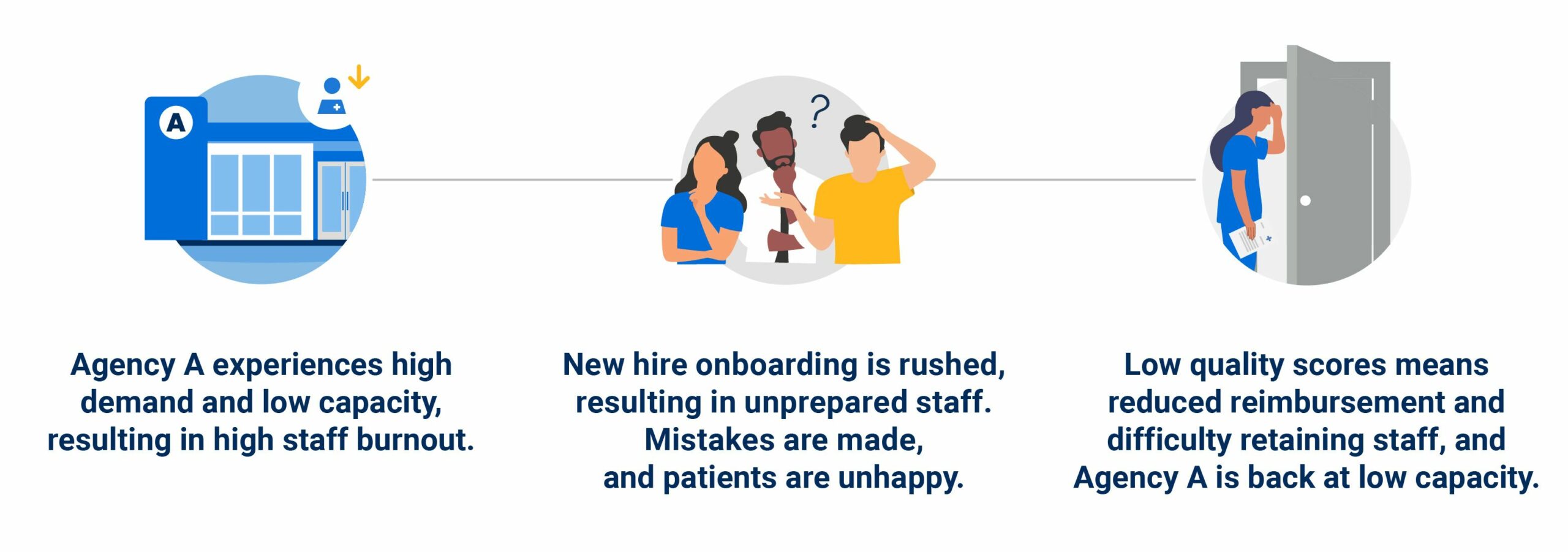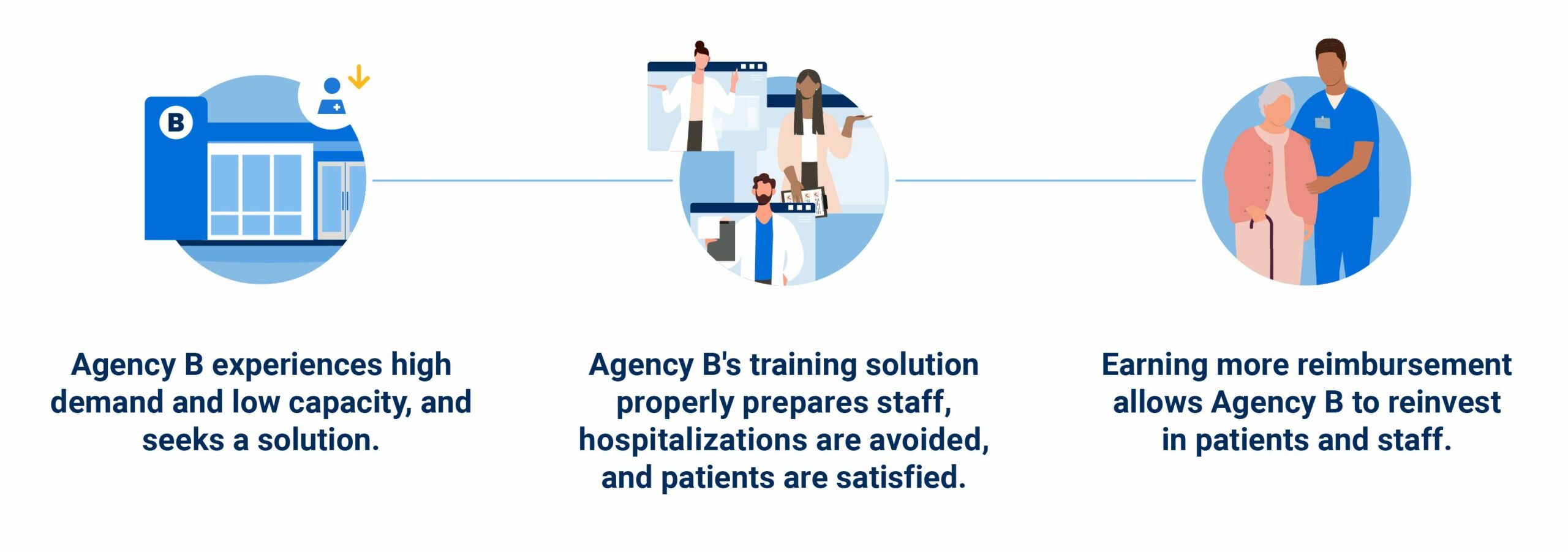Creating a Home Health Care Virtuous Cycle to Improve Clinical Access and Maximize Reimbursement

The demand for home health care has risen dramatically in recent years, with demand often exceeding capacity and even forcing agencies to turn away referrals.1 At the same time, clinician turnover remains high, heavy backfilling of roles is required, and payment models are changing. Home health agencies have an ongoing need to recruit, onboard, and retain nurses in an attempt to solve the gap in capacity.
There are two additional problems at play with the first being increased demographic demand:
According to data from the U.S. Census Bureau, the number of people aged 65 and older in the United States has grown to approximately 55 million in 2020. Every day 10,000 more people turn 65 and qualify for Medicare,2 and within the next six years, every member of the Baby Boomer generation will qualify for Medicare. That means Medicare spending is expected to more than double over the next decade due to increased enrollment and health care costs. Complicating these factors is that more patients each year simply prefer to receive care in the comfort of their own homes.3
The second is clinical access.
- 11,000 new nurses enter home health each year to help keep up with the rising demand.
- Home health nurse turnover rate is a staggering 32 percent.4
- Approximately 118,000 nurses would need onboarding each year to solve this growing problem.
- Clinical access shortages have forced agencies to turn away an unprecedented 76 percent of referrals last year.5
- More higher acuity patients with complex conditions are now being referred to home health rather than inpatient care.6
This all adds up to more competition between agencies for a smaller field of nurses seeking jobs. Because of the rush to boost capacity in the short term, many of these new nurses will wind up receiving training created for other settings. Without their agency providing evidence-based education, they may feel like they need to turn to substandard or unvetted sources like YouTube, leading to a knowledge gap that can have serious consequences for patients. Complicating matters are the new reimbursement models introduced over the past decade that have shifted the industry to value-based care.
For all of these reasons, a holistic home health ecosystem has become critical to success; otherwise, agencies run the risk of falling into the home health ‘vicious circle.’
The Home Health ‘Vicious Circle’
Picture this scenario: Agency ‘A’ has been experiencing high demand for the past several years, but they’re having trouble keeping up with clinical capacity. Hiring new nurses in a competitive market has been challenging, and the nurses they already have are showing the telltale signs of burnout. Referral rejections are high, and morale is low. The decision is made to rush new nurse onboarding to boost clinical capacity in the short term and lower the rejection rate.
Let’s see how that might play out:

So how could this have been avoided? Let’s look at another agency that took a different approach and achieved the home health ‘virtuous cycle.’
The Home Health ‘Virtuous Cycle’
Agency ‘B’ is experiencing the same unprecedented clinical demand affecting the entire home health industry. But they’ve found a superior training solution, one that offers excellent onboarding training, remediation training, and on-the-go booster courses to support nurses from day one to year five and beyond.

Not only have they had a banner year in improving patient outcomes and satisfaction, the higher reimbursement rates they’ve earned now allow them to reinvest in patient care and staff, creating a virtuous cycle that can continue year over year. Staff are more satisfied, reducing burnout and improving patient outcomes. This makes Agency B a much more attractive place to work when hiring nurses in a competitive field, giving them an advantage when attracting the best talent. Staff satisfaction is improved, clinical competency is high, the patients are receiving the best possible care, and the agency continues to thrive.
How MedBridge Can Help
Traditional onboarding isn’t enough to keep up with the rapid changes to home health that have occurred over the past few years. You need an entire digital ecosystem to support your growing clinical capacity needs. MedBridge’s In-Home Essentials provides a comprehensive solution that addresses all of these challenges, allowing home health agencies to support nurses along their entire career path. From onboarding to career advancement, our solution allows nurses to quickly master necessary home health skills, access high quality training on the go, and learn advanced skills to provide even patients with the most complex needs the best care possible.
And MedBridge is already providing these solutions to top home health agencies around the country. MedBridge is:
The most effective platform to grow more nursing capacity
- The only all-in-one, proven solution to help agencies see more patients faster by reducing time-to-productivity of nurses
Your partner for value-based care
- With the industry shift to value-based purchasing, agencies need a partner that will ensure they can achieve and document the best outcomes to maximize reimbursement.
Chosen by 6 of the top 10 largest agencies
- With a 12+ year history as a trusted partner to companies in the acute care and ambulatory markets, MedBridge is trusted by the industry’s largest organizations.
MedBridge In-Home Essentials includes:
Home Health Onboarding Solution
With more care shifting to the home, quickly preparing new hires for the field is essential. Our Home Health Onboarding Solution allows agencies to boost staff readiness with effective, engaging education and easy-to use delivery and reporting tools.
Meet regulatory requirements and reduce risk while improving quality of care and patient satisfaction with our online skills assessment checklist and engaging, evidence-based skills training. This effective solution includes:
Digital Skills Checklist:
Customize training programs to focus on identified skill gaps.
Video-Based Skills Library:
Boost knowledge retention and master home health- and hospice-specific skills with bite-sized lessons.
Reporting & Analytics Dashboard:
Assign checklists, simplify preceptor assessment, and review skill acquisition.
Poor OASIS documentation can be costly. Provide your staff with expert-led onboarding and refresher training to ensure accurate outcomes and reimbursement.
Quality Improvement Solution
Improve OASIS accuracy and reduce readmissions by focusing on quality.
Decrease unnecessary in-person visits and cost of care with effective patient management.
Clinical Procedure Manual
Support nurses from onboarding to career advancement, helping them quickly master necessary home health skills and access high quality training on the go.
Conclusion
The home health industry is facing an inflection point, with agencies simultaneously staring down record demand and also monumental challenges. By adopting an ecosystem model, agencies have the opportunity to come out of this crisis moment stronger than ever—staff satisfaction improves, patients receive the best possible care, and your agency continues to thrive. How each agency decides to proceed will determine whether they’ll be treading water while caught in a vicious circle, or riding the virtuous cycle to the benefit of their staff and the patients they serve. For more information on how MedBridge can help, request a demo.
- https://homehealthcarenews.com/2023/08/amid-historically-high-rejection-rates-heres-how-home-health-providers-are-maintaining-positive-referral-relationships/
- https://www.hhs.gov/aging/index.html
- https://www.mckinsey.com/industries/healthcare/our-insights/from-facility-to-home-how-healthcare-could-shift-by-2025
- Daamen, M.A.M.J., Hamers, J.P.H., Gorgels, A.P.M. et al. Heart failure in nursing home residents; a cross-sectional study to determine the prevalence and clinical characteristics. BMC Geriatr 15, 167 (2015). https://doi.org/10.1186/s12877-015-0166-1
- Nair R, Lak H, Hasan S, Gunasekaran D, Babar A, Gopalakrishna KV. Reducing All-cause 30-day Hospital Readmissions for Patients Presenting with Acute Heart Failure Exacerbations: A Quality Improvement Initiative. Cureus. 2020 Mar 25;12(3):e7420. doi: 10.7759/cureus.7420. PMID:32351805; PMCID: PMC7186095.
- https://www.mckinsey.com/industries/healthcare/our-insights/from-facility-to-home-how-healthcare-could-shift-by-2025





